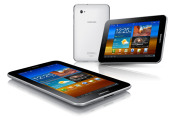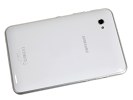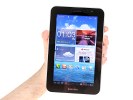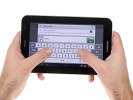Introduction
Apple gave the world the tablet. Samsung gave the world a choice. It’s not as simple of course as narrowing it down to an iPad vs. a Galaxy Tab. Nearly every phone maker out there has a tablet to offer. But the fact is that whatever size you want and whatever screen you like - Samsung most likely have it.





Samsung Galaxy Tab 7.0 Plus official pictures
Samsung have tablets stretching from 7 to 10.1 inches of screen diagonal. And these are either Super AMOLEDS or LCDs with the resolution ranging from WSVGA (600 x 1024) to well above HD. There are 3G and Wi-Fi enabled combos or Wi-Fi only versions. Users can choose between 16/32/64 GB of inbuilt storage. With all that variety on offer, it was obviously time to go back to where it all started.
If anyone needed a refresh, it would be the original Samsung P1000 Galaxy Tab. A single-core powered Froyo-running tablet has little left to offer and the 7.0 Plus does well to send it into retirement. The slimmer and lighter upgrade more than doubles the processing power and runs the latest tablet-tailored version of Android, Honeycomb 3.2. .
The Galaxy Tab 7.0 Plus is one of the two tablets of the house (along with the Galaxy Tab 7.7) to use Samsung's very own Exynos chipset - a dual-core ARM Cortex-A9 processor and Mali-400MP graphics. As you are about to see, this SoC does quite well in the benchmarks, beating the NVIDIA Tegra2 competitors on almost every count.
Key features
- 7.0" 16M-color PLS TFT capacitive touchscreen of WSVGA resolution (1024 x 600 pixels)
- Weighs 345 g
- Exynos chipset: Dual-core 1.2GHz ARM Cortex-A9 processor; 1GB of RAM; Mali-400MP GPU
- Android 3.2 Honeycomb with TouchWiz UX UI
- Quad-band GPRS/EDGE and tri-band 3G with HSPA connectivity (HSDPA, 21 Mbps; HSUPA, 5.76 Mbps)
- Support for voice calls, texts and MMS
- 16/32 GB of built-in memory
- 3.2 MP autofocus camera, 2048x1536 pixels, LED flash, geotagging
- 2.0 MP front-facing camera; native video calls
- 720p HD video recording @ 30 fps
- Wi-Fi 802.11 a/b/g/n Wi-Fi Direct, dual-band, Wi-Fi hotspot
- Stereo Bluetooth v3.0
- HDMI TV-out (adapter required), USB host (adapter required)
- microSD card slot
- Standard 3.5 mm audio jack
- Adobe Flash 11 support
- GPS with A-GPS support; digital compass
- 1080p DivX/XviD/MKV video support with subtitles
- Accelerometer and proximity sensor; three-axis Gyroscope sensor
- Polaris office document editor preinstalled
- Infrared port, Peel Smart Remote app preloaded
- 4000 mAh Li-Po rechargeable battery
Main disadvantages
- Smallest screen with the lowest resolution in the Samsung tablet lineup
- Has a non-replaceable battery
- Uses a proprietary 30-pin connector port for charging and connectivity
- One of the lowest capacity batteries in the range




Samsung Galaxy Tab 7.0 Plus live pictures
On the other hand, Samsung seem to have a superior alternative in the Galaxy Tab 7.7. It's powered by the same Exynos chipset - clocked higher - but boasts a WXGA Super AMOLED screen in a gorgeously slim body. All that beauty costs a small fortune though and gives the seven-inch Samsung tablet a space to fill as the affordable option in the tablet line.
But there's still a whole review to go before we can call the Galaxy Tab 7.0 Plus value for money. Let’s get busy then, shall we? The hardware inspection starts right after the break.

No comments:
Post a Comment